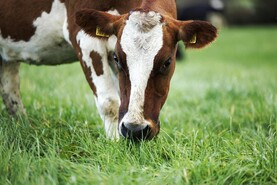The arrival of much-needed rain across parts of the country over the last seven days has been welcomed by most.
Showers have been very localised which has left some parts of the country still waiting for rain, but the forecast for the weekend and into next week is for more widespread rainfall.
Grass availability is still very variable across farms and management decisions are also variable because of this.
After the rain growth rates will improve so it is vital to walk the farm every five days in order to make informed decisions.
Grass deficit
On farms with a low average farm cover (AFC) that have had some rain, now is the time to reduce demand in order to give grass a chance to recover.
Allow cover per livestock unit (C/LU) to rise to 170kg DM/LU and then increase demand in line with growth to maintain this AFC.
Grass surplus
In some cases there may be a surplus of grass on farm. Increase demand by reducing supplementation levels in order to avoid having to make surplus bales.
Surplus paddocks were not taken out during the dry weather, leaving them available for grazing if grass ran tight that are above 1,700kg DM/ha can now be cut.
If you had stopped spreading fertiliser during the dry weather and have received rain or rain is forecast in your area follow the cows or cattle with 21 units of nitrogen per acre (one unit of nitrogen per acre per day of the rotation).
If you continued spreading fertiliser over the dry spell just continue following the cows/cattle as normal. At this stage of the year it is important to get grass back on target as we plan to start building covers from the middle of August.
Swardwatch
Walk the farm every five days to assess growth and grass availability.Hold average farm cover above 500kg DM/ha and target C/LU of 170kg DM/LU on dairy farms and 12-14 days ahead on beef farms.Where AFC is low increase supplementation after rain to allow grass supply to recover.Continue on a rotation length of 21 days.If you had stopped spreading nitrogen, follow cows/cattle with 20-25 units of nitrogen per acre.
The arrival of much-needed rain across parts of the country over the last seven days has been welcomed by most.
Showers have been very localised which has left some parts of the country still waiting for rain, but the forecast for the weekend and into next week is for more widespread rainfall.
Grass availability is still very variable across farms and management decisions are also variable because of this.
After the rain growth rates will improve so it is vital to walk the farm every five days in order to make informed decisions.
Grass deficit
On farms with a low average farm cover (AFC) that have had some rain, now is the time to reduce demand in order to give grass a chance to recover.
Allow cover per livestock unit (C/LU) to rise to 170kg DM/LU and then increase demand in line with growth to maintain this AFC.
Grass surplus
In some cases there may be a surplus of grass on farm. Increase demand by reducing supplementation levels in order to avoid having to make surplus bales.
Surplus paddocks were not taken out during the dry weather, leaving them available for grazing if grass ran tight that are above 1,700kg DM/ha can now be cut.
If you had stopped spreading fertiliser during the dry weather and have received rain or rain is forecast in your area follow the cows or cattle with 21 units of nitrogen per acre (one unit of nitrogen per acre per day of the rotation).
If you continued spreading fertiliser over the dry spell just continue following the cows/cattle as normal. At this stage of the year it is important to get grass back on target as we plan to start building covers from the middle of August.
Swardwatch
Walk the farm every five days to assess growth and grass availability.Hold average farm cover above 500kg DM/ha and target C/LU of 170kg DM/LU on dairy farms and 12-14 days ahead on beef farms.Where AFC is low increase supplementation after rain to allow grass supply to recover.Continue on a rotation length of 21 days.If you had stopped spreading nitrogen, follow cows/cattle with 20-25 units of nitrogen per acre. 





 This is a subscriber-only article
This is a subscriber-only article











SHARING OPTIONS: